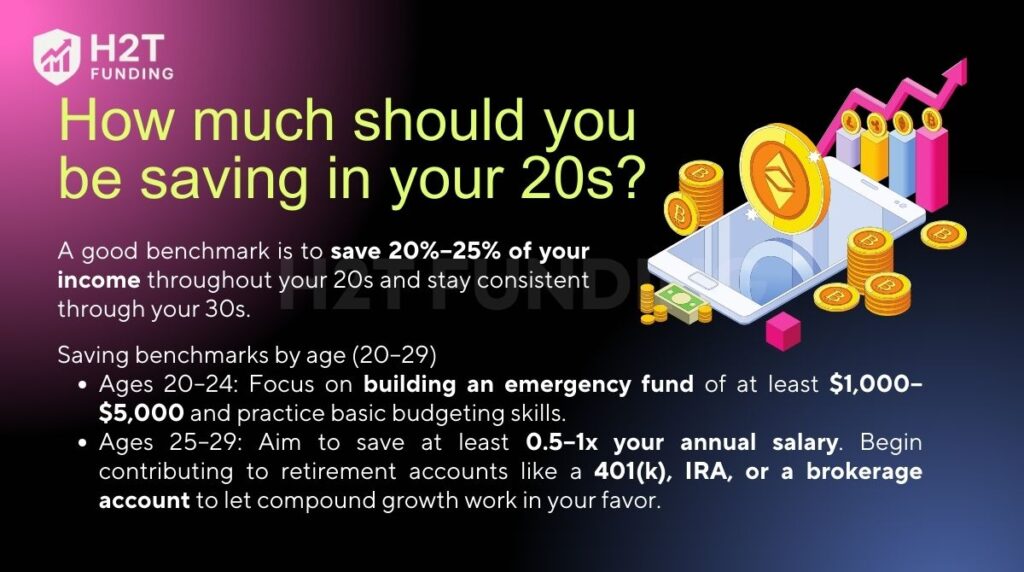You’re in your 20s, starting your first job or still in school, and the big question pops up: “Am I saving enough?” This is when savings habits begin to shape your future and define how well you handle financial obligations over time. Knowing how much should you be saving in your 20s gives you a clear benchmark and prevents you from falling behind later.
This guide, H2T Funding, will break down savings targets, age-based benchmarks, and practical steps you can take, even with a low income. You’ll see how small, consistent actions today can build a strong foundation for long-term goals like buying a home, financial independence, or early retirement.
Key takeaways
- A good benchmark is to save 20%–25% of your income throughout your 20s, but starting with 10% and increasing over time still builds strong momentum.
- Steps to start and boost savings in your 20s include budgeting, automating transfers, reducing big expenses, increasing income, investing early, and avoiding bad debt.
- Building an emergency fund in your early 20s and aiming for 0.5x–1x your annual salary saved by your late 20s sets you up for long-term success.
- Consistency and discipline matter more than perfection; small habits repeated over time are what create lasting financial security.
1. Why is saving in your 20s so important?
Saving in your 20s matters because time is your greatest advantage. The earlier you begin, the longer compound interest has to work, turning even small contributions into significant growth over decades. Missing out on these early years makes it harder to catch up later.

It also builds the financial base for bigger financial goals. Whether you dream of buying a house, starting a business, or achieving financial freedom, consistent saving creates the stability you’ll need. Without that base, opportunities can slip by when money becomes the main barrier.
Finally, saving protects you from falling into debt traps. Credit card balances, student loans, or personal loans can quickly pile up. Building savings now reduces this risk and gives you breathing room for unexpected expenses, helping you stop living paycheck to paycheck as you grow your financial security.
2. How much should you be saving in your 20s?
A good benchmark is to save 20%–25% of your income throughout your 20s and stay consistent through your 30s. This answers the common question of how much you should save in your 20s while keeping your goals realistic.
Financial experts often suggest that consistently putting away 20% of each paycheck helps you build an emergency fund and prepare for bigger financial milestones later.

One popular framework is the 50/30/20 rule:
- 50% of income for essentials like housing, food, and bills.
- 30% for wants such as travel, dining, or hobbies.
- 20% for savings and investments.
If saving 20% feels overwhelming at first, start with 10% and increase it gradually each year as your income grows. The key is building consistency, not perfection.
Saving benchmarks by age (20–29)
- Ages 20–24: Focus on building an emergency fund of at least $1,000–$5,000 and practice basic budgeting skills.
- Ages 25–29: Aim to save at least 0.5–1x your annual salary. Begin contributing to retirement accounts like a 401(k), IRA, or a brokerage account to let compound growth work in your favor.
In your 20s, there’s no “perfect” number, but having a clear savings target keeps you motivated and accountable. Whether you start with 10% or reach 25%, the most important part is to develop the habit early and stay consistent.
3. Practical steps to start and boost savings in your 20s
When you’re in your 20s, saving can feel almost impossible: rent, student loans, and daily expenses take most of your paycheck. But knowing what I should be saving for in my 20s, like an emergency fund, retirement, and short-term goals, gives direction and purpose.”
I remember thinking I could barely spare anything when I first started working. But once I built small systems to manage my money, saving became less about sacrifice and more about creating freedom. These steps can help you do the same.
At a glance: the six key steps to build savings in your 20s
- Create a budget and track expenses
- Automate savings to pay yourself first
- Reduce major recurring costs
- Increase your income with side hustles or skill-building
- Start investing early, even with small amounts
- Avoid or pay off high-interest debt
Read on for a detailed guide to each step and start turning your 20s into a decade of financial growth.

3.1. Step 1: Create a budget and track expenses
The first step is knowing where your money goes. Use a simple spreadsheet or budgeting app to log your income and spending. Look for small leaks, like daily coffee shop visits or frequent takeout meals; these small cuts can free up money for savings.
I was shocked when my budgeting app showed I was spending nearly $400 a month on takeout and coffee. Switching to home-brewed coffee and cooking just three extra meals a week saved me a significant amount without feeling like a huge sacrifice.
3.2. Step 2: Automate your savings (Pay yourself first)
Treat saving as a non-negotiable bill. Set up an automatic transfer from your paycheck into a high-yield savings or investment account as soon as you get paid. This way, you remove the temptation to spend first and save later.
3.3. Step 3: Reduce major expenses
Housing, transport, and food often eat up the largest share of your income. Consider living with roommates, finding more affordable housing, or using public transportation. Cooking at home and bringing meals to work or school can cut costs dramatically.
3.4. Step 4: Increase your income
Boosting savings isn’t only about cutting back; it’s also about earning more. Look into side hustles like freelancing, tutoring, or online gigs. At the same time, invest in yourself with new skills or certifications that raise your earning potential. Don’t hesitate to negotiate your starting salary either.
Explore more ways to increase your income:
3.5. Step 5: Start investing, even with small amounts
You don’t need thousands to begin. Explore beginner-friendly options such as index funds, retirement accounts, or long-term savings plans. The earlier you invest, the more time compound interest has to multiply your wealth. Always diversify and learn before committing.
3.6. Step 6: Avoid bad debt
Credit card debt and high-interest personal loans can erase years of progress. Use credit cards only if you can pay them off in full each month. Focus on staying debt-free or paying down high-interest balances before increasing your savings rate.
Saving in your 20s isn’t just about cutting coffee or skipping nights out. By budgeting, automating, managing big costs, and starting to invest early, you create a structure where money works for you. These savings strategies, when repeated consistently, turn small beginnings into lasting financial security.
See more:
4. Tips to build savings in your 20s (even with a low income)
When I first started working, my paycheck felt too small to save anything meaningful. Still, I realized that even with a limited income, small habits could slowly build real progress. The changes didn’t feel dramatic at first, but over time, they created stability I didn’t think was possible.
Here are a few tips that worked for me and can work for you, too.
- Set up auto-transfer savings as soon as you get paid: Treat savings like a fixed bill. Moving money automatically into a separate account helps ensure you don’t spend it unintentionally.
- Avoid lifestyle creep when your income rises: Spending more just because you earn more is the fastest way to stall progress.
- Track expenses with apps or spreadsheets: Tools like YNAB, PocketGuard, or even a basic Excel sheet can reveal surprising spending patterns.
- Pay off high-interest debts before increasing savings: Clearing expensive debt gives your money room to grow. Once I paid off my credit card balance, I redirected the monthly payments into my savings account, and the results added up quickly.
Having a modest salary doesn’t prevent you from saving. Automating transfers, holding back lifestyle upgrades, tracking spending carefully, and prioritizing debt payoff can help you stop living paycheck to paycheck and build momentum that strengthens your finances year after year.
5. FAQs
A good starting point is 20% of your monthly income. If that feels too high, begin with 10% and increase it each year. Consistency matters more than hitting the perfect number right away.
Priority one is your emergency fund (savings). Once you have 3-6 months of living expenses saved, you should absolutely start investing. The ideal strategy is to do both: continue adding to savings while consistently investing, even small amounts.
By age 25, aiming for half to one year of your annual income saved is realistic. By 30, try to reach at least one year’s worth of income. These milestones create a strong foundation for retirement planning.
Yes, $10,000 at 25 is a solid milestone. It often covers a decent emergency fund and shows you’ve built consistent saving habits. If your income is higher, you may want to push toward 0.5x to 1x your annual salary.
For many people, $200–$500 per month is a realistic target depending on income and expenses. The key is to make saving automatic and gradually increase the amount as your income grows.
Yes, you can start small with investing once you have an emergency fund of at least $1,000–$3,000. Many platforms allow you to begin with just $50 or $100, which gets you into the habit early.
A common benchmark is one year’s worth of income by age 30. For example, if you earn $50,000 annually, try to have $50,000 saved across cash and investments.
Absolutely. Saving $1,000 per month in your 20s is excellent, especially if your income allows it. Over a decade, that adds up to $120,000 plus interest and investment growth.
$300,000 alone is usually not enough for a comfortable retirement. However, if invested wisely and combined with other income sources like pensions or Social Security, it can support part of your retirement plan. Starting early helps you grow beyond that number.
6. Conclusion
Saving in your 20s doesn’t have to be perfect. What matters most is getting started and building habits you can carry for decades. Even small, steady contributions add up and give you the confidence to handle emergencies, chase big goals, and secure long-term freedom.
So if you’re wondering how much should you be saving in your 20s, aim for 20% of your income, and watch compound interest work its magic. If 20% feels out of reach right now, begin with what you can and increase it as your income grows.
Want to explore more ways to take control of your money? Check out our Cash Flow & Saving Strategies section at H2T Funding for step-by-step guides to plan smarter, spend wisely, and save consistently.





